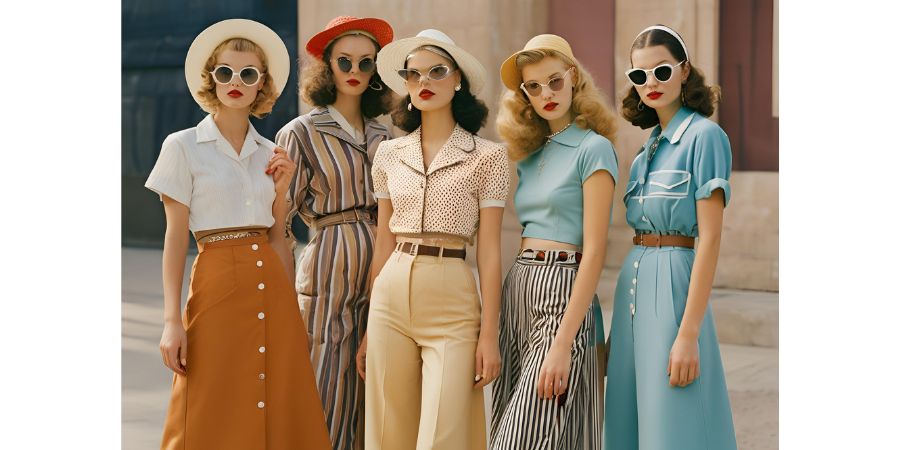Retro fashion refers to clothing styles, accessories, and looks that are inspired by or directly taken from past decades. Characterized by distinct elements from earlier eras, retro fashion often evokes a sense of nostalgia and a fascination with the past. It bridges the gap between vintage styles and contemporary aesthetics, combining the old with the new in a unique and modern interpretation. Retro fashion plays an integral role in today’s trends, allowing for a fresh take on classic looks that continue to influence the fashion industry.
The resurgence of retro fashion in recent years highlights its importance in modern style. As global trends evolve and adapt, retro clothing has emerged as a staple in both high-end fashion houses and everyday wardrobes. This revitalization isn’t merely a passing trend; it’s part of a larger cycle where fashion continually revisits and reinterprets past styles. In this article, we will explore the history, evolution, and current relevance of retro fashion, alongside practical tips for incorporating it into your own wardrobe.
Semantic Keyphrases: Retro fashion meaning, Vintage clothing resurgence, Retro style overview
The Origins and History of Retro Fashion
The origins of retro fashion are intrinsically tied to the broader history of 20th-century style. Fashion evolves in response to the changing times, social movements, and cultural shifts. What we now refer to as retro style draws inspiration from a wide range of periods and moments in fashion history, spanning from the 1920s to the 1980s.
1920s: The Roaring Twenties and Art Deco
The 1920s marked a major departure from previous fashion norms, with women embracing shorter hemlines, bobbed haircuts, and a more androgynous silhouette. The Art Deco movement played a crucial role, influencing everything from patterns to jewelry and even the construction of garments. The flapper dress, with its loose, drop-waist design, and jazz-inspired accessories became synonymous with the era. This rebellious embrace of modernity laid the foundation for what would later become known as retro fashion.
1950s: The Rise of Rock n’ Roll and Poodle Skirts
The 1950s are often remembered for the dramatic shift in social and cultural norms, with the rise of rock ‘n roll and the iconic image of teenage rebellion. Fashion during this period reflected a mix of youthful exuberance and more conservative styles. Poodle skirts, leather jackets, and cat-eye glasses became symbols of the era. Men embraced greaser looks, while women sported full skirts, cardigans, and saddle shoes. The rock ‘n roll revolution influenced how fashion reflected youth culture, a theme that would continue in retro fashion.
1960s: Mod Fashion and the Influence of Youth Culture
The 1960s ushered in the mod movement, characterized by geometric patterns, bold colors, and sharp, tailored silhouettes. Mod fashion represented a rejection of the traditional and embraced the vibrancy of modern life. British designers such as Mary Quant introduced the mini skirt, which became a symbol of the era’s sexual liberation. On the other side of the Atlantic, the counterculture movement produced the hippie look, full of flowing garments, ethnic prints, and psychedelic colors. These influences would become a mainstay in later retro revivals.
1970s: Disco Fever and Bell-Bottoms
The 1970s are often remembered for their iconic fashion moments, including bell-bottom jeans, platform shoes, and vibrant, patterned fabrics. Disco culture heavily influenced fashion, with glitzy, form-fitting outfits, metallic fabrics, and bold colors. The rise of the youth-driven counterculture also gave rise to bohemian and hippie-inspired looks, with flowing dresses, fringe jackets, and earth tones becoming widespread.
1980s: Bold Colors, Oversized Silhouettes, and Punk Influence
The 1980s were defined by extravagant fashion choices, with neon colors, oversized blazers, and extravagant hairstyles. The punk rock movement, led by bands like the Sex Pistols and The Clash, brought DIY fashion elements like ripped clothing, leather jackets, and band t-shirts into the mainstream. On the other end of the spectrum, the preppy look—featuring polo shirts, pleated skirts, and cardigans—also became widely popular. This era’s bold, rebellious fashion choices laid the groundwork for the retro aesthetic we celebrate today.
Semantic Keyphrases: History of retro fashion, Fashion trends of the 20th century, Vintage fashion styles
Key Elements of Retro Fashion
Retro fashion isn’t defined by a single look or style; it encompasses a wide range of elements, from fabrics and prints to iconic accessories. Understanding these key components can help define what makes a particular outfit feel “retro.”
Vintage Fabrics, Prints, and Patterns
Retro fashion often incorporates fabrics and prints that evoke a particular era. Polka dots, florals, plaid, and houndstooth are frequent patterns associated with retro styles. Fabrics like tweed, corduroy, and denim also make regular appearances. These materials evoke a sense of nostalgia, tying the wearer to the past, but with a modern flair.
Iconic Retro Clothing Items
A few clothing items have become staples of retro fashion. Flared jeans, bell-bottoms, mini skirts, and leather jackets all evoke distinct periods in history. Dresses with cinched waists and flared skirts recall 1950s femininity, while the mod mini skirt and shift dresses are emblematic of the 1960s.
Accessories that Define Retro Looks
Accessories play a significant role in retro fashion. Cat-eye sunglasses, chunky jewelry, wide belts, and silk scarves were common in several decades. The statement pieces from these decades have become timeless symbols of retro fashion, transforming simple outfits into bold style statements.
Footwear and Hairstyles
Footwear and hairstyles are equally integral to retro fashion. Platforms, saddle shoes, and ankle boots are often paired with flared jeans or skirts. As for hairstyles, beehive updos, pixie cuts, and long, voluminous waves evoke past eras and continue to be emulated in modern retro-inspired looks.
Semantic Keyphrases: Key elements of retro style, Retro fashion accessories, Popular retro clothing items
How Retro Fashion Is Different from Vintage Fashion
While retro and vintage fashion may appear similar, there are notable distinctions between the two. Vintage refers to genuine clothing from a particular era, typically ranging from 20 to 100 years old. These are original garments, preserved and worn as they were in their time.
In contrast, retro fashion refers to contemporary clothing that imitates or is inspired by past styles. Retro items are usually newly made, but they draw heavily on the trends and aesthetics of previous decades. Retro fashion is essentially a modern interpretation of vintage, offering the chance to embrace classic looks without wearing actual vintage clothing. This distinction is crucial for those navigating the world of second-hand shopping, as vintage and retro items serve different functions in one’s wardrobe.
Semantic Keyphrases: Difference between retro and vintage, Vintage fashion vs. retro style, Modern interpretation of vintage trends
Retro Fashion Today: How It Has Influenced Modern Styles
Today, retro fashion has a significant presence in both high-end and mainstream fashion. The influence of retro style is visible across pop culture, where celebrities and influencers regularly incorporate retro elements into their wardrobes. Celebrities like Zendaya, Harry Styles, and Florence Welch are known for blending vintage-inspired pieces with modern flair, influencing millions of followers to adopt retro looks.
Moreover, retro fashion’s resurgence has had a profound impact on the high street and designer brands. Major fashion houses have incorporated retro elements into their collections, from oversized blazers to 70s-inspired floral prints. The prominence of thrift stores and online marketplaces, such as Depop and eBay, has made retro shopping more accessible to a younger audience eager to discover pre-loved items.
Another important factor in retro fashion’s revival is sustainability. The trend of recycling and reusing older styles aligns with the growing interest in sustainable fashion practices. Embracing retro style is, in many ways, a sustainable choice, allowing consumers to repurpose and reimagine past fashions for today’s world.
Semantic Keyphrases: Retro fashion in modern times, Celebrity influence on retro fashion, Sustainable retro clothing
How to Incorporate Retro Fashion into Your Wardrobe
Incorporating retro fashion into your daily style can be both exciting and daunting. Here are some practical tips for embracing retro style:
- Choose pieces that suit your body type: Retro clothing can be flattering for any body type, but it’s important to pick items that enhance your natural shape. For example, high-waisted trousers or A-line dresses can create an hourglass silhouette.
- Mix and match: Combine retro items with modern pieces to create a balanced and cohesive look. Pair a vintage jacket with contemporary skinny jeans or mix a vintage-inspired blouse with your favorite modern accessories.
- Where to shop: Thrift stores, vintage boutiques, and online platforms like Etsy or Poshmark are great places to find retro-inspired clothing. Alternatively, if you’re not into second-hand shopping, many modern brands offer retro-inspired collections.
- DIY and customization: Embrace your creativity by adding your own twist to retro fashion. You can tailor vintage clothing to fit your personal style, or even create your own accessories, like a handmade bandana or embroidered denim jacket.
Semantic Keyphrases: How to wear retro fashion, Mixing modern and retro clothes, Where to buy retro clothing, Retro fashion DIY tips
Popular Retro Fashion Substyles
There are many retro substyles, each representing a different decade or cultural movement. Here are a few of the most popular:
- 50s Rockabilly and Pin-up Style: Think poodle skirts, gingham prints, and red lipstick.
- 60s Mod Fashion: Geometric patterns, shift dresses, and go-go boots.
- 70s Boho and Hippie Chic: Flared jeans, peasant blouses, and ethnic prints.
- 80s Neon, Punk, and New Wave: Bright colors, leather jackets, and graphic tees.
- 90s Grunge and Rave Culture: Plaid shirts, combat boots, and oversized jackets.
Semantic Keyphrases: Different retro fashion substyles, Popular vintage-inspired looks, Retro style by decade
Retro Fashion: Why It’s Here to Stay
The cyclical nature of fashion means that trends inevitably return. Nostalgia plays a significant role in why retro fashion remains relevant today. Social media platforms, such as Instagram and TikTok, further fuel the revival of past styles, allowing users to discover and share vintage-inspired looks. This combination of nostalgia, social media influence, and sustainable practices ensures that retro fashion will remain a significant part of modern style for years to come.
Semantic Keyphrases: Why retro fashion is popular, The return of retro styles, Nostalgia in fashion
Conclusion
Retro fashion is more than just a passing trend; it’s a cultural movement that continues to shape modern style. By drawing inspiration from past decades, retro fashion connects the past with the present, offering a way to express individuality while embracing nostalgia. As you experiment with retro looks, don’t be afraid to mix the old with the new and create a style that’s uniquely your own. Retro fashion is a testament to the enduring power of design, proving that sometimes, the past truly is prologue.
Semantic Keyphrases: Retro fashion’s impact, Embracing retro style, Fashion trends of the past and present


